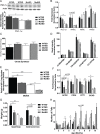Long-term bezafibrate treatment improves skin and spleen phenotypes of the mtDNA mutator mouse
- PMID: 22962610
- PMCID: PMC3433471
- DOI: 10.1371/journal.pone.0044335
Long-term bezafibrate treatment improves skin and spleen phenotypes of the mtDNA mutator mouse
Abstract
Pharmacological agents, such as bezafibrate, that activate peroxisome proliferator-activated receptors (PPARs) and PPAR γ coactivator-1α (PGC-1α) pathways have been shown to improve mitochondrial function and energy metabolism. The mitochondrial DNA (mtDNA) mutator mouse is a mouse model of aging that harbors a proofreading-deficient mtDNA polymerase γ. These mice develop many features of premature aging including hair loss, anemia, osteoporosis, sarcopenia and decreased lifespan. They also have increased mtDNA mutations and marked mitochondrial dysfunction. We found that mutator mice treated with bezafibrate for 8-months had delayed hair loss and improved skin and spleen aging-like phenotypes. Although we observed an increase in markers of fatty acid oxidation in these tissues, we did not detect a generalized increase in mitochondrial markers. On the other hand, there were no improvements in muscle function or lifespan of the mutator mouse, which we attributed to the rodent-specific hepatomegaly associated with fibrate treatment. These results showed that despite its secondary effects in rodent's liver, bezafibrate was able to improve some of the aging phenotypes in the mutator mouse. Because the associated hepatomegaly is not observed in primates, long-term bezafibrate treatment in humans could have beneficial effects on tissues undergoing chronic bioenergetic-related degeneration.
Conflict of interest statement
Figures





References
-
- Trifunovic A, Wredenberg A, Falkenberg M, Spelbrink JN, Rovio AT, et al. (2004) Premature ageing in mice expressing defective mitochondrial DNA polymerase. Nature 429: 417–423. - PubMed
-
- Kujoth GC, Hiona A, Pugh TD, Someya S, Panzer K, et al. (2005) Mitochondrial DNA mutations, oxidative stress, and apoptosis in mammalian aging. Science 309: 481–484. - PubMed
Publication types
MeSH terms
Substances
Grants and funding
LinkOut - more resources
Full Text Sources
Other Literature Sources
Medical
Molecular Biology Databases

